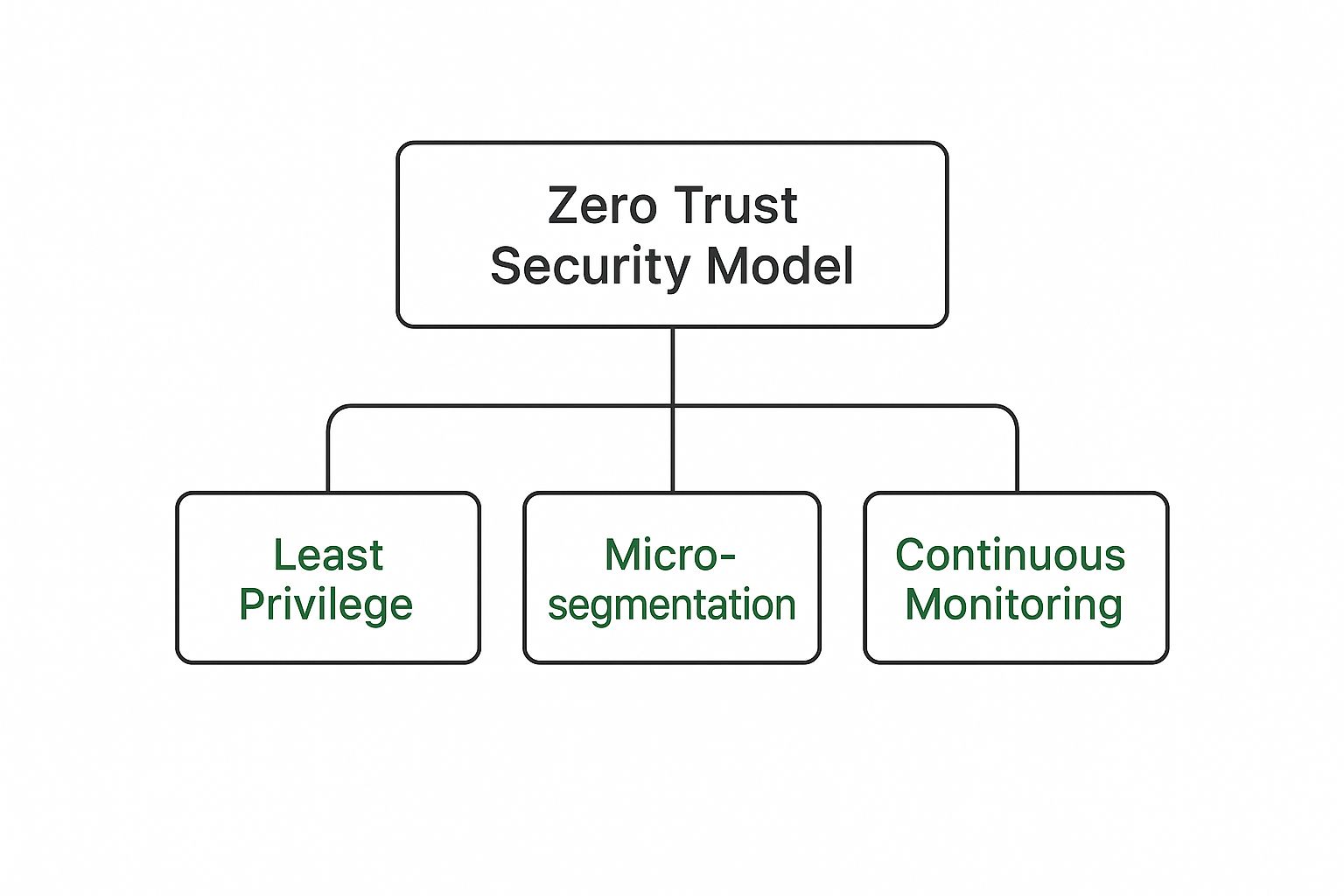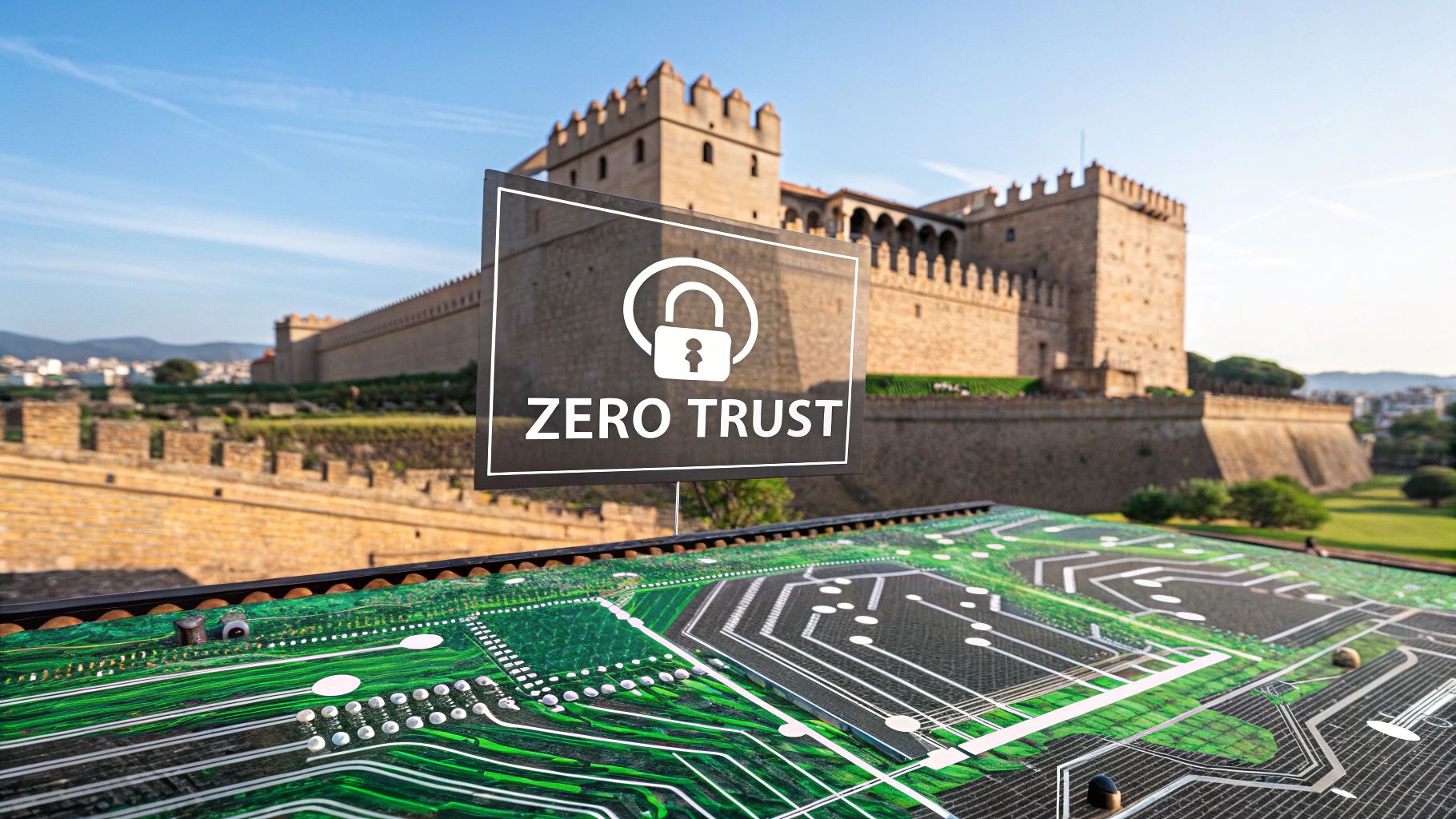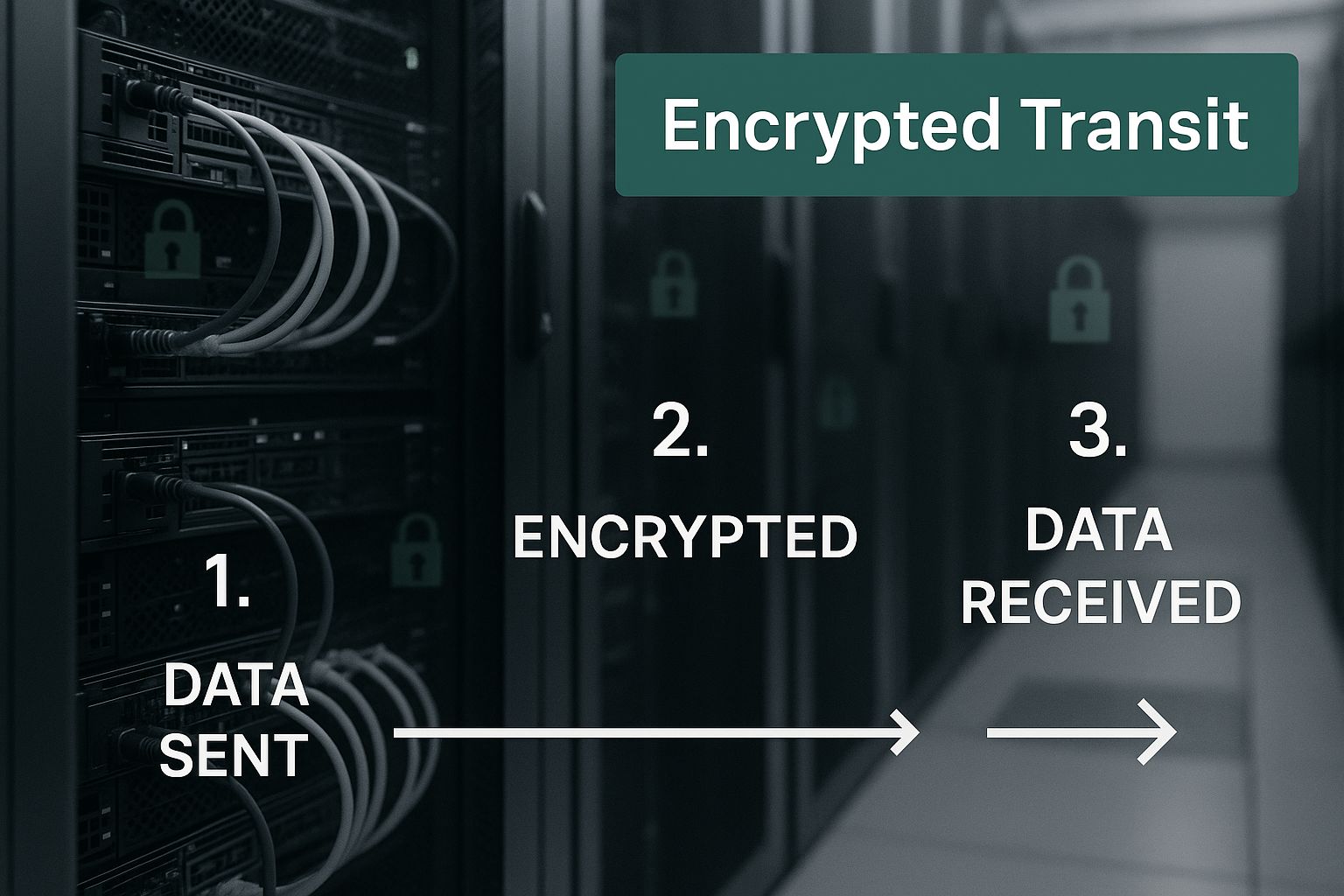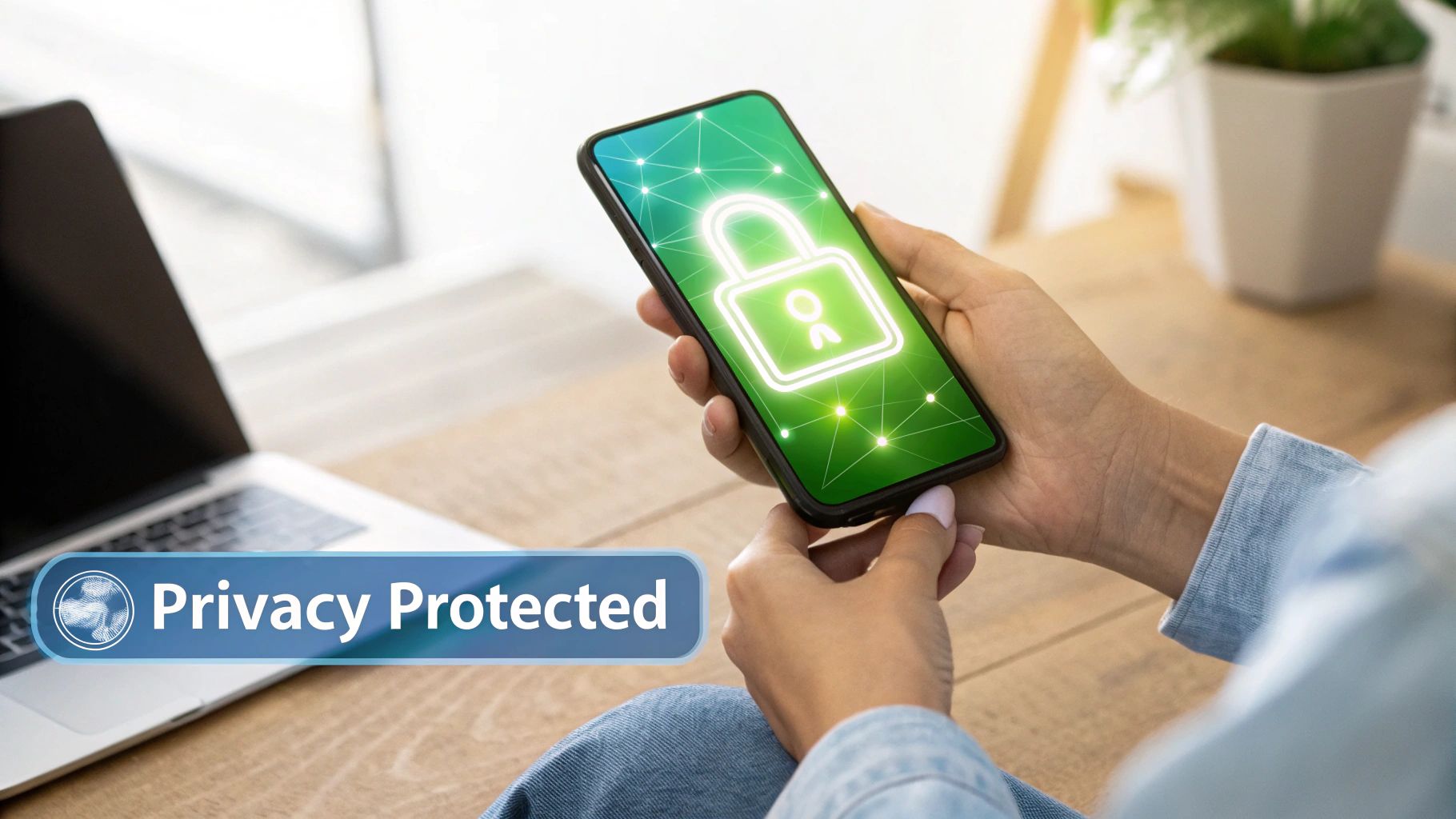Here’s the simple truth: Zero trust security is a modern cybersecurity strategy built on one foundational principle—never trust, always verify. It completely throws out the old idea that anything inside a corporate network is automatically safe. Instead, it demands strict identity verification for every single user and device trying to access resources, regardless of where they are.
Moving Beyond The Digital Castle And Moat

For decades, we protected our digital assets like a medieval fortress. We built a strong wall (the firewall) and a deep moat (the network perimeter) around our sensitive data and applications. If you were inside those defenses, you were considered trusted by default. This "castle-and-moat" model made sense when everyone worked in the office on company-issued computers.
But the way we work today has completely shattered that old fortress. People now connect from home, coffee shops, and airports. They use a mix of personal and company devices to access applications that no longer live on-site but are scattered across different cloud environments. This new, distributed reality means the concept of a secure "inside" of the network has essentially vanished.
The Problem With Assumed Trust
The fatal flaw in the old model is its reliance on assumed trust. Once a threat actor breaches the outer wall—often with something as simple as stolen login credentials—they have free rein to move laterally across the internal network. This is precisely why traditional security struggles to keep up with modern cyber threats.
Zero trust turns this entire model on its head. It starts with the assumption that threats exist both outside and inside the network. Because of this, trust is never a default setting; it must be continuously earned and re-verified.
This fundamental shift from trusting a location to verifying an identity is why so many organizations are making the switch. The market for zero trust solutions is booming, projected to grow from USD 36.96 billion in 2024 to an incredible USD 92.42 billion by 2030. If you're interested in the numbers, you can dive deeper into this trend by reading the full zero trust security market report on grandviewresearch.com. This growth isn't just hype; it's driven by the urgent need to secure data in a world without perimeters.
Traditional Security vs Zero Trust Security At a Glance
To really understand the difference, it helps to see the two philosophies side-by-side. The following table breaks down the core thinking behind the outdated castle-and-moat approach versus the modern Zero Trust model.
| Security Aspect | Traditional Security (Castle-and-Moat) | Zero Trust Security (Never Trust, Always Verify) |
|---|---|---|
| Core Philosophy | Trust anything inside the network. | Trust no one, verify everything, every time. |
| Primary Defense | A strong network perimeter (firewalls). | Micro-segmentation and identity verification. |
| Trust Model | Implicit trust based on location. | Explicit trust earned through continuous authentication. |
| Access Control | Broad access once inside the network. | Least-privilege access, granted per-session. |
| Assumption | The internal network is a safe, trusted zone. | Threats can exist anywhere, inside or out. |
| Focus | Protecting the network perimeter. | Protecting resources (data, apps, services). |
As you can see, the change is a complete overhaul in security thinking. It’s a move from a static, location-based defense to a dynamic, identity-centric one that is far better suited for today's complex IT environments.
The Three Pillars of Zero Trust Security
To really get what zero trust is all about, we have to move past the "never trust, always verify" soundbite and look at its core structure. The entire strategy rests on three fundamental pillars that work in tandem to create a tough, adaptive defense. Don't think of them as separate items on a checklist; they're interconnected ideas that give the whole framework its power.
These pillars give us a clear blueprint for tearing down old-school, perimeter-based security and wrapping protection directly around our most valuable assets: our data and applications. Each one tackles a critical piece of the modern cybersecurity puzzle, from the moment someone tries to log in to the uncomfortable reality that a breach could happen at any time.
Pillar 1: Verify Explicitly
The first and most important pillar is to verify explicitly. This means every single request to access a resource—any resource—is treated as a potential threat until it's proven safe. It doesn't matter if the request is from a trusted employee, a company laptop, or from inside the office. The system challenges it. Every. Single. Time.
Think of it like getting into a secure government facility. An employee can't just stroll in because they work there. They have to show their ID badge at every checkpoint, every single day. Zero trust applies this same logic to the digital world. It authenticates and authorizes access based on all the data points it has in that moment, including:
- User Identity: Is this a known employee, a contractor, or an automated service?
- Device Health: Is the device updated, malware-free, and meeting our security policies?
- Location: Is the user connecting from their usual city or somewhere totally unexpected?
- Service or Application: What exact resource are they trying to reach?
This pillar ensures trust is never implied or carried over from a previous session. It has to be earned, right here and now.
Pillar 2: Use Least Privileged Access
Once a user is verified, the second pillar kicks in: use least privileged access. This principle is simple but powerful. Users should only get the absolute minimum level of access they need to do their jobs. Nothing more.
It’s like giving a hotel cleaner a keycard that only opens the specific rooms on their cleaning list, and only during their work hours. That card won't open the general manager’s office or the cash vault. This approach dramatically shrinks the potential damage if a user's account ever gets hijacked.
Even if a hacker steals an employee's password through a phishing email, their access is so limited they can't move around the network and cause widespread harm. This is a game-changer for defending against account takeovers. To learn more about this common attack, check out our complete defense guide against email security threats.
Pillar 3: Assume Breach
The final pillar is a mindset shift: assume breach. This forces you to design your security from the inside out. Instead of pouring all your energy into keeping attackers out, you operate under the assumption that they're already inside.
This prompts a critical question: "If an attacker is already on our network, how do we limit the damage?" The answer is all about containing the "blast radius" of an attack.
This is where technologies like micro-segmentation are so important. By breaking your network up into tiny, isolated zones, you can stop a threat in its tracks. If one small segment is compromised, the breach is contained there, protecting the rest of your critical systems. The infographic below shows how these core ideas—least privilege and micro-segmentation—are at the very heart of the Zero Trust model.

As the diagram shows, a solid Zero Trust strategy depends on enforcing strict access controls (least privilege), containing threats (micro-segmentation), and staying vigilant (continuous monitoring). Together, these three pillars transform your security from a brittle wall into a smart, flexible defense system built for today's world.
How a Zero Trust Architecture Is Built

It’s one thing to grasp the principles of zero trust, but actually putting them into practice is a whole different ballgame. A genuine zero trust architecture isn't a single product you can just buy and install. It’s a carefully orchestrated system where specific technologies work in concert to enforce that core rule: "never trust, always verify."
Think of it like building a high-tech security system for a smart home. You wouldn't just slap a heavy-duty lock on the front door and call it a day. Instead, you'd integrate cameras, motion sensors, and smart locks on every single window and door. All these components feed information back to a central hub that makes intelligent, real-time security decisions. Each piece has its own job, but it’s their combined strength that creates a truly secure environment.
This integrated approach is absolutely essential because attackers are relentless. Old security models just aren't cutting it anymore—in 2022, 39% of UK companies experienced a cyber-attack. In that same timeframe, cybercrime impacted over 53 million people in the U.S. alone. These aren't just numbers; they represent a clear and present danger that demands a more dynamic defense. You can get a deeper look at the market drivers in this deep dive into zero trust security market trends.
The Core Technology Components
A solid zero trust framework stands on several key technological pillars. Each one tackles a specific piece of the access puzzle, from figuring out who the user is to locking down the network itself. While the exact tools you use might differ, they almost always fall into these fundamental categories.
-
Identity and Access Management (IAM): This is the brain of the whole operation. IAM solutions are the central authority for creating, managing, and defining user identities and what they’re allowed to touch. They are the first and last word on who gets in.
-
Multi-Factor Authentication (MFA): If IAM is the brain, think of MFA as the uncompromising bouncer at the door. It adds a powerful layer of security by demanding two or more ways to prove you are who you say you are. This makes a simple stolen password almost useless to an attacker.
-
Micro-segmentation: This is your internal security detail. It works by chopping up the network into tiny, isolated zones and containing all traffic within those segments. So, even if an attacker manages to breach one part of the network, micro-segmentation stops them from moving laterally to compromise everything else.
A Zero Trust strategy moves security away from the network perimeter and places it directly around the data and applications themselves. It's a shift from protecting the "network" to protecting the "resource."
This is a fundamental change in how we approach security architecture. It guarantees that protection is applied consistently, no matter where the resource—or the user—happens to be.
Securing Every Connection Point
Beyond managing who gets in and segmenting the network, a complete zero trust setup has to secure the devices connecting to it and keep a close eye on all activity. This is where endpoint security and advanced analytics come into play, feeding the system crucial data to make those split-second access decisions.
Endpoint Security: This is all about making sure every device—whether it's a laptop, server, or mobile phone—is healthy and compliant before it gets access. It checks for things like up-to-date antivirus software, the latest OS patches, and other security hygiene markers. A device that fails these checks can be blocked from ever touching your critical applications.
Security Analytics and Automation: These tools are the system's ever-watchful eyes. They constantly pull in and analyze data from every corner of your environment, hunting for suspicious behavior. By using machine learning, they can spot anomalies that might signal a compromised account or an active threat. From there, they can automatically trigger a response, like instantly revoking access or forcing the user to re-authenticate. Protecting the data as it moves is also crucial, which is why understanding end-to-end encryption is so important.
Putting Zero Trust Into Practice
Theory is one thing, but how does zero trust actually hold up in the real world? When you strip away the buzzwords, it’s a dynamic, adaptive shield that protects organizations in scenarios where older security models would simply crumble.
Let's walk through a few everyday situations where a zero trust approach makes all the difference. These examples really show how its core ideas—always verify, grant minimal access, and assume you've already been breached—work together to build a powerful defense.
Securing the Modern Remote Workforce
Think about a marketing specialist working from their local coffee shop. Under the old model, the moment they logged into the company VPN, they were "on the network" and trusted. This is a massive security hole. If their laptop or login details were stolen, an attacker could have the keys to the kingdom.
Zero trust flips that script entirely.
-
Always Verify, Everywhere: Before our specialist can even open the marketing drive, the system demands multi-factor authentication (MFA). It doesn't stop there. It also checks that their laptop's security software is patched and that no strange processes are running in the background.
-
Least Privilege in Action: Access is granted only to the marketing files and the specific campaign tools they need for their job. They can't wander into the company's financial records or the engineering team's code repositories. This simple step contains any potential breach to a tiny, manageable area.
This granular control means people can be productive from anywhere without the company having to blindly trust their connection.
Protecting Hybrid Cloud Environments
Most businesses today run a mix of their own on-premise servers and cloud services from providers like AWS or Azure. This hybrid setup can be a real headache to secure, and attackers love to exploit it by hopping from a less-secure cloud app into a critical on-site database.
Zero trust stops this "lateral movement" dead in its tracks using a technique called micro-segmentation. It essentially builds a secure, isolated bubble around each and every application, no matter if it's running in the cloud or in your own server rack.
So, if an attacker manages to break into a public-facing web server in the cloud, they're trapped inside that bubble. They can't sniff network traffic or try to connect to the internal database because the zero trust policy explicitly forbids that communication. The "blast radius" of the attack is kept incredibly small.
Granting Secure Contractor Access
Finally, let's say you bring on a third-party developer for a six-week project. They need access to one specific code repository and a single testing server—and absolutely nothing else.
With zero trust, you can create a policy that is incredibly specific and temporary. The developer gets access only to those two resources, only from their registered device, and only for the six-week duration of their contract. The second their contract expires, access is automatically shut off.
This is the principle of least privilege executed perfectly. It eliminates the all-too-common risk of forgotten accounts and lingering access that could be exploited months or years down the line.
The proven effectiveness of this model is driving serious investment. In the U.S. alone, the Zero Trust market was valued at USD 17.79 billion in 2024 and is projected to surge to nearly USD 62.92 billion by 2032. For a closer look at this growth, you can dive into these detailed zero trust statistics on zerothreat.ai.
Here is the rewritten section, designed to sound completely human-written and natural.
Your Roadmap to Implementing Zero Trust

Thinking about moving to a zero trust model? It's important to see it as a gradual evolution, not an overnight project. This is a fundamental shift in how you approach security, touching both your tech stack and your company culture. Trying to do it all at once is a classic mistake and a sure path to frustration. A smarter, phased approach is what sets successful teams apart.
Everything starts with a simple, but crucial, question: what are we actually trying to protect? You can't secure what you can't see. This initial discovery work is the foundation for every single security decision you'll make down the line.
Phase 1: Identify and Map Your Assets
First things first, you need a comprehensive inventory of your most important assets. I’m not just talking about a list of servers and databases. You have to get granular and think about the data itself. What are your "crown jewels"? Is it sensitive customer data, priceless intellectual property, or confidential financial records? Pinpoint what would hurt the most if it fell into the wrong hands.
Once you know what you're protecting, the next step is to understand how it moves and who uses it. This means mapping out your data flows. Trace the paths to see which users, devices, and applications legitimately need access to that critical information. When you have a clear picture of what "normal" looks like, spotting unusual or suspicious activity becomes infinitely easier. For example, a common attack vector is a compromised email account, making it a critical chokepoint to secure. You can dive deeper into safeguarding this area in our complete guide to business email security.
This mapping exercise gives you the real-world context you need to build a zero trust environment that's based on how your business actually works, not on outdated assumptions.
Visibility is everything in zero trust. You have to see and understand all your data, assets, and access pathways before you can even begin to secure them properly.
Phase 2: Architect the Network and Create Policies
With your asset map in hand, you can start architecting your zero trust network. This is where you bring in powerful concepts like micro-segmentation to create small, isolated security zones around your most valuable assets. Think of it as building digital vaults around your crown jewels. The core idea is to make "deny" the default setting for everything, granting access only when a specific, verified request is made.
From there, you'll craft your security policies. These aren't the old, static "set it and forget it" rules. A modern zero trust policy is dynamic and context-aware. It should look at multiple factors before ever granting access, including who the user is, the health of their device, their location, and the specific resource they want to reach.
For example, a solid policy might enforce these conditions:
- User: Must be an authenticated member of the marketing team.
- Device: Must be a company-managed laptop with the latest security patches.
- Resource: Only allows access to the Q4 marketing campaign folder.
- Action: All other attempts to access this resource are automatically blocked.
Phase 3: Address Hurdles and Foster Culture
Let's be realistic—no major change like this comes without a few bumps in the road. A common challenge is dealing with legacy systems. Many older applications were built in an era of high trust and simply weren't designed for this kind of security model. In these cases, you often have to get creative, perhaps by placing the old app inside a modern, segmented "wrapper" to strictly control who and what can talk to it.
But the technical hurdles are often easier to solve than the human ones. The biggest challenge? Culture. You're asking everyone to shift their mindset from "trust by default" to "verify first." This requires a concerted effort to educate employees on why these changes are happening and how the new security checks ultimately protect them and the company. Getting buy-in at every level, from the newest hire to the seasoned executive, is an ongoing process of communication, training, and reinforcement. It’s not just an IT project; it’s a company-wide commitment.
Here is the rewritten section, crafted to sound like it was written by an experienced human expert.
The Future of Security Is Built on Verification
So, after everything we've covered, it's clear that zero trust isn't just another buzzword or a passing trend. It's a fundamental shift in our thinking—a necessary evolution in how we defend what matters in a world where the old rules of security simply don't apply anymore. This isn't about buying one more piece of software; it’s about embracing a completely new mindset.
We've walked through the three core pillars that give this strategy its power: verifying explicitly, granting least privileged access, and always maintaining an assume breach mentality. These aren't just abstract concepts. They work together to build a security posture that's both tough and agile, wrapping protection directly around your most critical data and applications instead of just guarding a flimsy, outdated network border.
Think of it this way: Zero trust creates a living, breathing security framework. It’s constantly questioning, checking, and re-validating who gets access to what, and why. That's why it's becoming the new gold standard—it meets modern threats and scattered workforces head-on.
At the end of the day, adopting this "never trust, always verify" approach is the most logical and effective way forward. It gives you a practical, step-by-step guide to creating a more secure future for your organization, no matter how big or small it is.
Your Top Zero Trust Questions, Answered
Even after you get the hang of the basic idea, it's totally normal to have a few lingering questions about how zero trust actually plays out in the real world. Let's tackle some of the most common ones to really solidify your understanding.
Think of this less as installing a new program and more as adopting a completely new mindset for your entire security operation.
Can I Just Buy a "Zero Trust" Product?
Not really. You can't just go out and buy a single "zero trust" box and call it a day. It’s a complete security strategy, a framework for how you approach security—not a product you can purchase off the shelf.
You'll definitely use specific technologies to make it happen, like Identity and Access Management (IAM) tools, Multi-Factor Authentication (MFA), and micro-segmentation software. But the real shift is philosophical. It's all about embracing the core principle of "never trust, always verify." You're moving away from trusting someone just because they're "inside the network" and toward a much stronger model where identity is everything.
Does This Mean I Can Get Rid of My Firewall?
No, zero trust doesn’t make tools like firewalls obsolete, but it does change their job description. Your firewall might still be great for blocking obviously bad traffic at the network’s edge, but it's no longer your one and only line of defense. It's not the sole gatekeeper of trust anymore.
In a zero trust world, security checks happen everywhere, at every single access request. This means the inside of your network is just as defended as the outside perimeter.
Traditional tools like firewalls become just one layer in a much deeper defense strategy. Security gets applied directly to the resource itself, not just the network it lives on.
Is This Too Complicated for My Small Business?
While the thought of a complete overhaul can feel overwhelming, small businesses can absolutely adopt zero trust principles piece by piece. The journey doesn't have to happen all at once. You can start with a few foundational steps that give you a big security boost right away.
- Start with Strong MFA: The single best place to begin is by requiring Multi-Factor Authentication on all your critical apps, especially email and any cloud platforms you use.
- Embrace "Least Privilege": Go through your user accounts and make sure people can only access the exact data and systems they need to do their jobs—and nothing more.
- Lock Down Your Endpoints: Ensure every single device (laptops, phones) that connects to your resources is up-to-date and secure.
Many cloud services you're probably already using have zero trust features built right in, making it easier than ever to get started. The key is to take it one step at a time instead of trying to do everything at once.
Ready to secure your communications with a platform built on privacy and trust? Typewire provides private, ad-free email hosting that puts you in control. Explore our features and start your free 7-day trial today.





